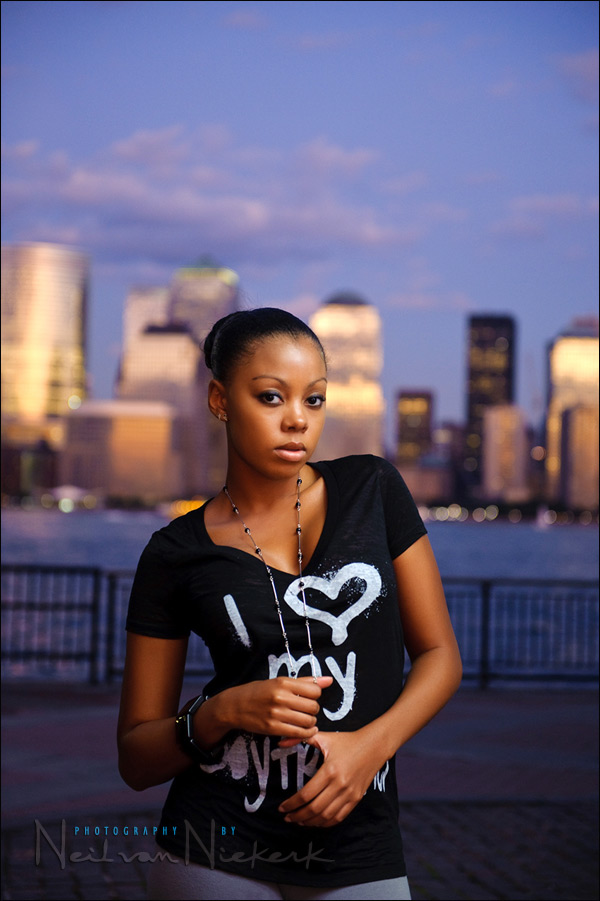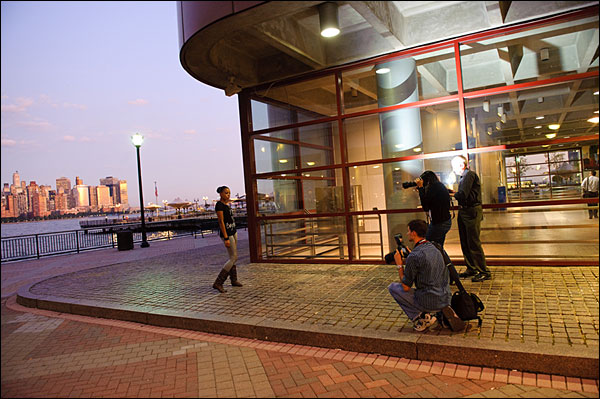
an example of using on-camera bounce flash outside
This photograph of our model, Precious, taken during a flash photography workshop, is an example from the practical session where we used areas outside to bounce our flash off. By adding that bit of light from our on-camera speedlights, we can sweeten the existing light.
Working in the early evening in lower light levels, it becomes easier to get effective light from our speedlight even when bounced off the side of a building.
camera settings: 1/60 @ f3.2 @ 800 ISO – on-camera TTL flash, bounced.
Nikon D3; Nikon 24-70mm f2.8G ED AF-S (B&H); Nikon SB-900
My starting point for my camera settings was to expose correctly for the city scene behind our model. Then I added the light from the speed light.
Here is the pull-back shot to show what we bounced our flash off …

The side of the Path train station in Jersey City. I bounced my flash a bit more forward of where you see that splash of light from the flashgun – part of the glass side, pillar and ceiling. I used the black foamie thing to flag my flash so that I was able to bounce it ‘forward’ towards our model, but NOT get any direct flash on her. This also gave me that directional look to the light from my flash. Note again, I bounced my flash forward, and not behind me where all the light would’ve been lost.
The key here is that we specifically posed our model here where there were surfaces to bounce our flash off!
Beautiful color modulation from light blue of sky through the darker blue of the water to the purplish blue of the pavement and back to light sky blue in her jeans! Wonderful how the f/3.2 golden background blur of twilight-reflecting skyline glass blends with the medium cocoa butter of her skin!
This appears to be fill flash. So why didn’t you use TTL instead of TTLBL? What difference, if any, would that have made? When you were setting for the ambient light, did you make any special adjustment for the cocoa-butter color of her skin and the black, but boldly white-lettered, shirt? Did you dial flash compensation up or down?
I’ve read and reread your excellent book. Now I repeatedly study its photos and their exposure data, trying to square that material with your stated general principles.
Frank, who is trying hard to master his D3, SB-900, black-foam for flash, as well as his Nikkor 70-200 2.8, 85 1.4, 14-24 2.8, and 50 1.4.
New to your site and you’ve opened my eyes to a new technique. On-Camera Flash is a lot more flexible than I’ve been led to believe.
When you take your shots, do you usually take a shot without a flash then turn it on and take another? Or do you run with your flash on and adjust as needed?
Hey Neil, can I ask a few questions please, and I dont know if your black foam thing is a ABBC or not but I have just got one so will if permitted talk in terms of a ABBC
Having just received my ABBC ultimate to replace my lightsphere I am loving the light it puts out, I can see the feathering in my pics, taking a little more time to think about taking pictures with it but not much….
My questions are these.
In the example above do you have the foam on the short side of the flash – I am guessing since its a port image you have it on the long side with the head at at about 35 degrees or so.
If I am correct in my assumption do you generally use your foam thing on the long side or short side of the flash ?
Again in the example above is the gobo side of the abbc on the camera left side of the flash
Would using the ABBC ultimate give you much (in this example) different light than the an all black ABBC and for bouncing flash, is an all black ABBC better than one with a small amount of white space ?
last but not least and guessing a hard one, what do you think is about the maximum distance you can get fairly usable bounced light from a surface like this.
thanks mate, sorry for all the questions
ciao
dp
Hi Neil,
I just shot my second wedding using various tidbits from your site.
(In particular, your ‘black foamie thing’, which in my case is actually just a more-or-less A5 square of black paper attached to my speedlight with a hairband…)
Thanks again for all of the excellent advice and tips you offer so freely.
Regards,
Andrew Westran
Durban, South Africa
https://www.flickr.com/photos/37871415@N00/
It’s really great to see a “how to” shot.
Thanks for a great blog!